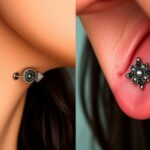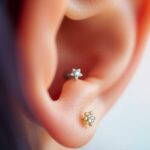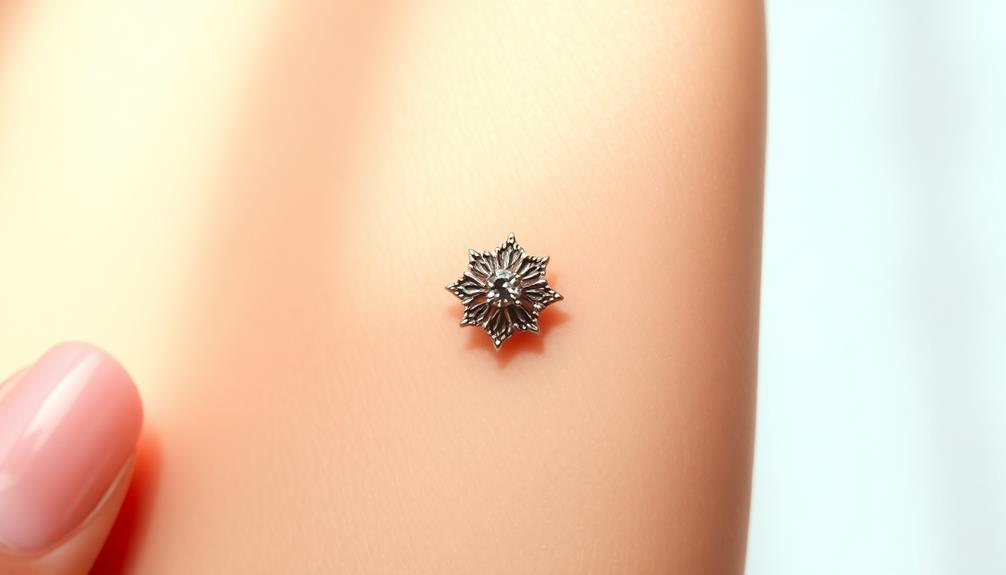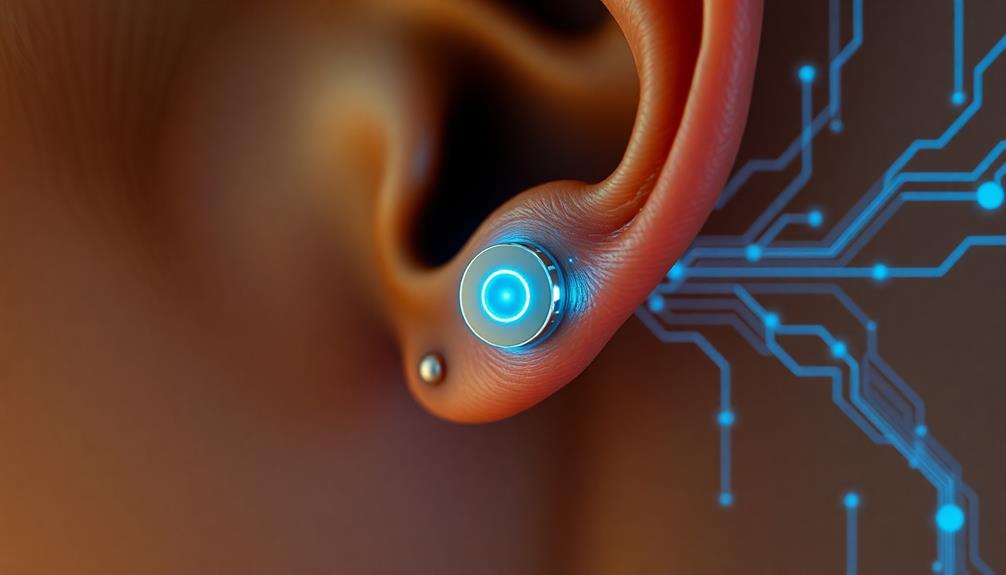Bridge piercings can be a striking way to express your individuality and style. Located horizontally on the nose, they offer an edgy aesthetic that might appeal to you if you're looking to stand out. The procedure involves minimal pain and a healing period of 8 to 10 weeks, with proper aftercare being essential to avoid complications. However, you should consider factors like potential allergic reactions to jewelry and the need for quality materials. If you're intrigued by this bold choice, there's plenty more to explore about the procedure, aftercare, and jewelry options available for you.
Key Takeaways
- Bridge piercings are ideal for those seeking a unique aesthetic and personal expression, appealing to a range of styles and cultures.
- The procedure involves minimal pain and has a typical healing time of 8 to 10 weeks, requiring proper aftercare for best results.
- Infection prevention is crucial; maintaining hygiene and using high-quality jewelry can significantly reduce risks during the healing process.
- Be aware of potential allergic reactions to jewelry materials, particularly nickel; opt for hypoallergenic options like titanium or surgical steel.
- Consider the cost of the piercing and aftercare products, as reputable studios may charge more for quality service and materials.
What Is a Bridge Piercing?

A bridge piercing, often referred to as an Earl or Erl piercing, is a unique body modification that runs horizontally across the bridge of your nose, typically situated between your eyes. This type of facial piercing is classified as a surface piercing, which means it goes through the skin rather than into a fleshy part of the body.
Because of this, bridge piercings are more susceptible to migration and rejection, making proper care essential.
When you choose a bridge piercing, the jewelry used is usually a short barbell. You can customize its placement and style to suit your personal aesthetic. This piercing is less common than nostril or septum piercings, often appealing to those who appreciate an edgy look and want to make a statement.
Many people opt for a bridge piercing not just for its visual appeal but also for cultural or spiritual reasons. It's a form of personal expression that highlights your individuality.
If you're considering this type of body modification, be sure to weigh the risks and rewards, as well as how it fits into your overall style and identity.
The Piercing Procedure
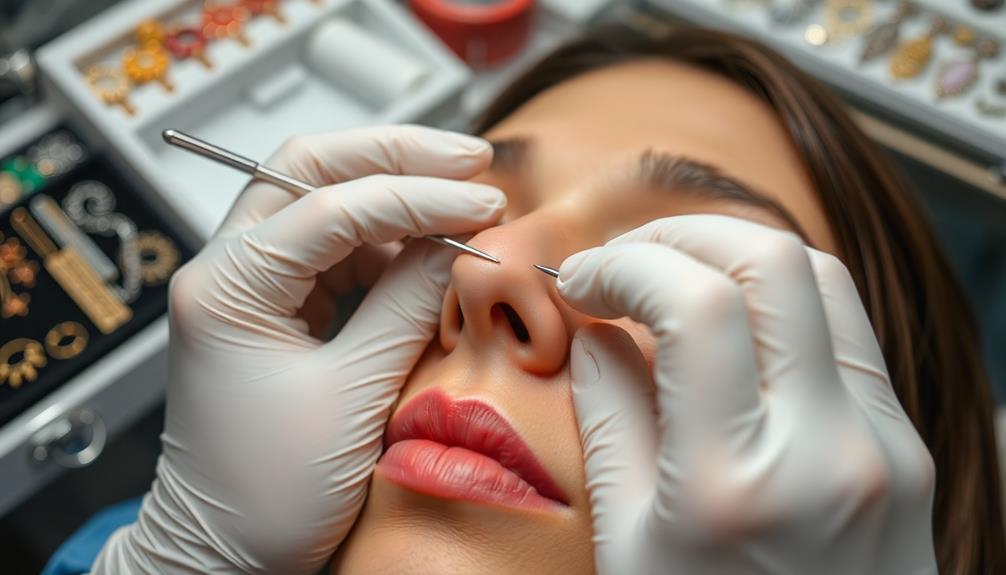
Getting a bridge piercing involves a straightforward procedure that prioritizes safety and precision. First, your experienced piercer will conduct a thorough skin assessment and discuss any potential risks. They'll mark the area for proper placement before proceeding.
Once you're ready, the piercer will clean your skin with an antiseptic solution and may use sterile saline to guarantee everything is hygienic. A hollow, sterile needle is then used to create the piercing, followed by the insertion of a short barbell that will sit horizontally across your nose bridge.
The entire process usually takes just a few minutes, and many find the pain minimal since the piercing goes through soft tissue rather than cartilage.
After getting your bridge piercing, it's important to keep the jewelry in place for about 8 to 10 weeks to allow for proper healing. During the healing process, you'll need to practice diligent aftercare, which includes monitoring for any signs of infection or complications.
Keeping the area clean and avoiding unnecessary touch will help guarantee a safe experience with your body modification.
Pain and Discomfort Levels
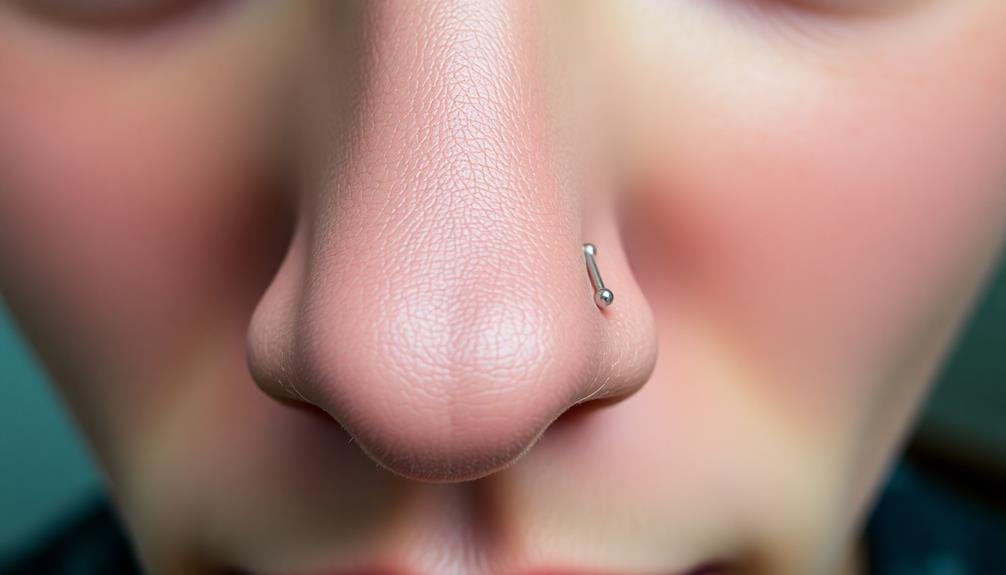
Experiencing a bridge piercing can lead to varying levels of pain and discomfort, often rated as moderate. Many individuals report feeling minimal discomfort during the procedure itself, primarily because the area lacks cartilage. The initial pain from the needle insertion usually lasts just a few seconds, although some may experience more discomfort from the skin clamping prior to the piercing.
Post-piercing, you might notice swelling and tenderness, which are common reactions. Healing times for a bridge piercing typically average between 8 to 10 weeks for visible healing, but complete internal healing can take several months. During this period, some soreness and discomfort may persist, especially as your body adjusts.
It's important to remember that pain tolerance is different for everyone. While some individuals rate the pain levels around 7/10, others find the experience considerably less intense.
Over-the-counter pain relievers like Ibuprofen or Paracetamol can effectively help manage any soreness you may encounter. Overall, if you're prepared for some initial discomfort and follow proper aftercare, a bridge piercing can be a manageable experience.
Safety Considerations
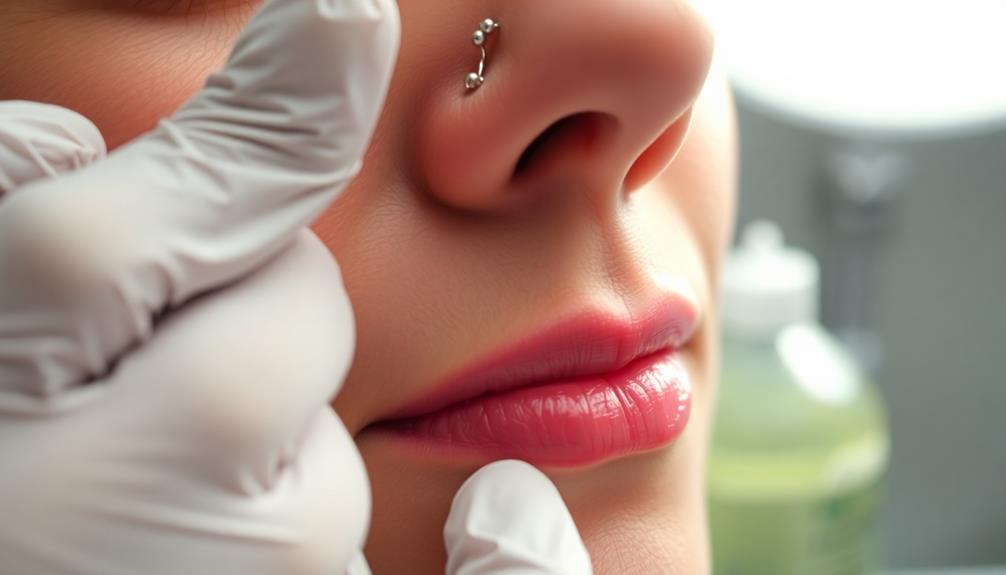
When considering a bridge piercing, safety should be at the forefront of your mind. The cleanliness and professionalism of your chosen piercing studio play an essential role in preventing infections. Always verify that the tools and surfaces are sanitized before your procedure.
Additionally, it's important to follow proper piercing care and hygiene practices after getting your piercing to minimize risks. You should also be aware of potential allergic reactions to jewelry materials, particularly nickel, which can irritate sensitive skin. Choose materials wisely to minimize these risks.
Additionally, be cautious during physical activities; twisting or pulling on the jewelry can lead to tearing, which could complicate your healing process.
Understanding the risks of migration and rejection is fundamental, especially since bridge piercings are surface piercings with less flesh to anchor them securely. For this reason, proper placement by a qualified professional piercer is critical.
They'll help verify the jewelry fits correctly and assess your individual risks.
Aftercare Instructions
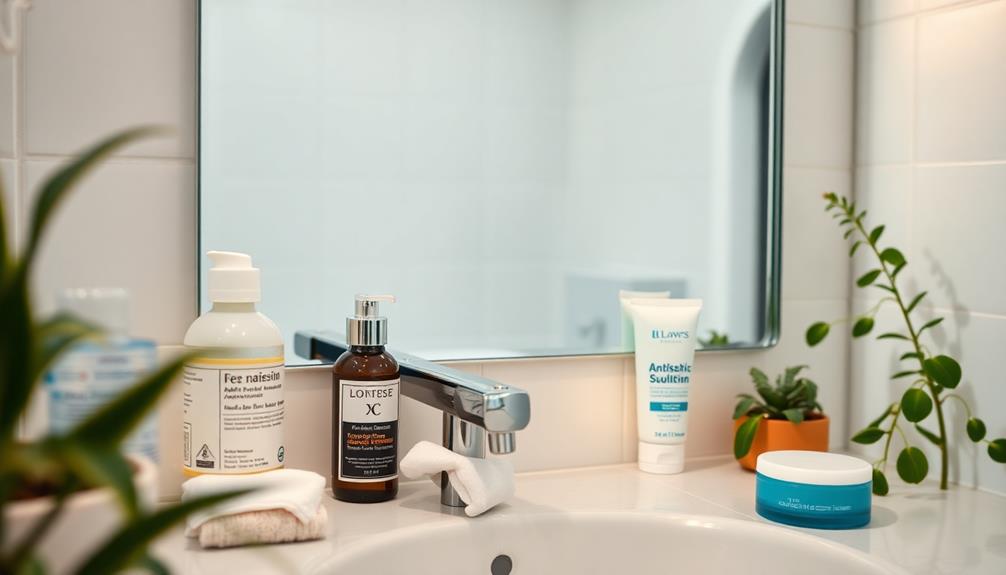
Taking care of your bridge piercing is essential for a smooth healing process.
You'll want to clean it twice a day with a saline solution or an antiseptic, while also avoiding any touching or twisting of the jewelry.
Keeping irritants away and monitoring for signs of infection will help guarantee your piercing stays healthy.
Cleaning Routine Essentials
Maintaining a proper cleaning routine for your bridge piercing is essential to prevent infection and guarantee a smooth healing process. Following these cleaning routine essentials will help you care for your new piercing effectively:
- Clean the area: Use a sterile saline solution or a gentle, fragrance-free soap to clean your bridge piercing 2-3 times daily. This promotes healing and keeps infection at bay.
- Wash your hands: Always wash your hands thoroughly before touching the piercing. This minimizes the risk of introducing bacteria, assuring proper care.
- Rinse gently: After applying soap, rinse the piercing gently with clean water. Avoid twisting or manipulating the jewelry during cleaning to prevent irritation.
- Pat dry: Use disposable paper towels to pat the area dry. Regular towels can harbor bacteria, so it's best to avoid them during the healing process.
Remember to avoid touching the piercing unnecessarily and refrain from exposing it to beauty or hair care products until it's fully healed, which typically takes 8-12 weeks.
Following these aftercare instructions from a reputable piercer assures your bridge piercings heal well.
Infection Prevention Tips
Infection prevention is vital for the health of your bridge piercing, guaranteeing a smooth healing journey. When getting a bridge piercing, follow these infection prevention tips closely during your piercing aftercare.
Clean your bridge piercing twice daily with a sterile saline solution or a recommended aftercare spray. This routine helps prevent infection and promotes healing.
Always wash your hands thoroughly before touching your piercing to minimize the risk of introducing bacteria. Additionally, avoid using harsh products like makeup or hair products near the piercing, as these can cause irritation and lead to infection.
It's important to monitor your piercing for signs of infection, such as excessive redness, swelling, or discharge. If you notice any of these symptoms, consult a professional immediately.
Lastly, during the healing period, don't submerge your piercing in pools, hot tubs, or potentially contaminated water. This precaution helps reduce the risk of infection.
Always choose a reputable studio for your piercing to guarantee the best possible care and technique. By following these tips, you can help guarantee your bridge piercing heals safely and beautifully.
Healing Time Expectations

When you get a bridge piercing, the typical healing duration is around 8 to 10 weeks, but complete inner tissue healing can take up to 8 months.
You might notice visible healing sooner, so it's important to watch for signs of proper healing and irritation.
Staying on top of aftercare and checking in with your piercer can help guarantee everything goes smoothly.
Typical Healing Duration
Healing from a bridge piercing typically takes around 8 to 12 weeks, but don't be surprised if complete healing of the inner tissue stretches to 8 months.
While you might notice visible healing sooner, usually within 6 weeks, maintaining proper aftercare throughout the entire healing process is crucial.
Here are some key points to keep in mind regarding your healing duration:
- Swelling and Tenderness: Expect some initial discomfort, which is normal as your body adjusts.
- Aftercare Solution: Use a gentle aftercare solution to clean the area and promote healing.
- Jewelry Replacement: Be cautious when replacing jewelry; pain during this process is common as the piercing heals.
- Professional Piercer Follow-ups: Regular check-ins with a professional piercer can help guarantee your healing process stays on track and address any complications.
Signs of Proper Healing
As your bridge piercing progresses through its healing stages, you'll notice key signs indicating it's on the right track. Typically, healing time for a bridge piercing ranges from 8 to 12 weeks, but complete inner tissue healing can take up to 8 months.
Early signs of proper healing include reduced swelling and tenderness. You should also watch for the absence of redness or discharge.
Consistent aftercare plays an important role in influencing your healing duration. While some discomfort is normal, persistent irritation or unusual symptoms may signal an infection, and you should address these concerns promptly.
Regular follow-ups with a professional piercer can help guarantee your piercing is healing correctly and allow you to ask any questions you might have.
If you notice any significant changes, like increased swelling or discomfort, it's vital to consult your piercer. They can assess whether your healing process is going smoothly or if additional care is needed.
Cost Factors
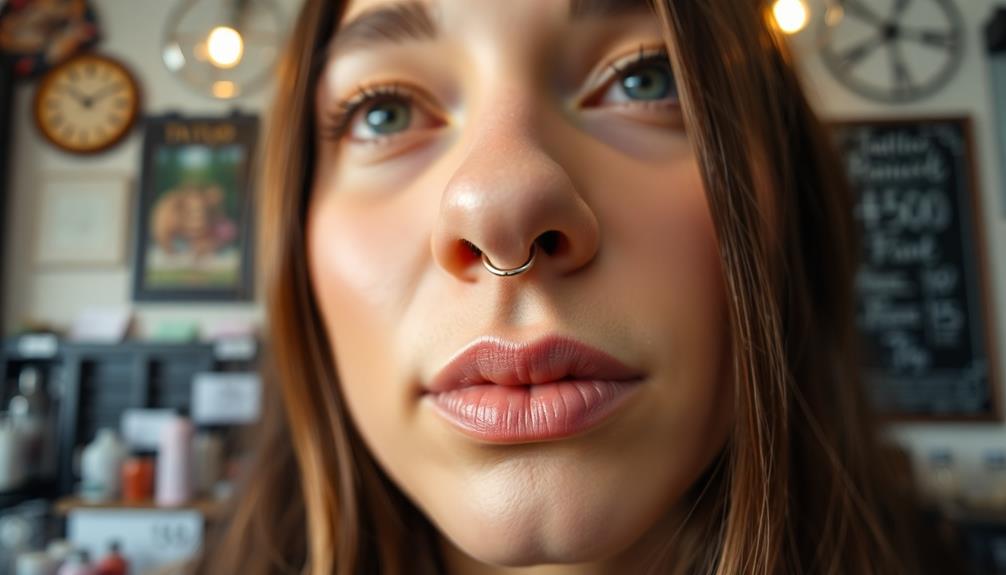
The cost of a bridge piercing can vary greatly based on several factors, including the studio's location and reputation. On average, you can expect to pay between $30 and $80 for the procedure. However, if you're in a metropolitan area, fees can increase considerably, with some premium studios charging upwards of $100.
Here are some key cost factors to keep in mind:
- Studio Location: Prices in metropolitan areas are usually higher due to demand and overhead.
- Reputation: Well-known studios may charge more for their expertise and quality service.
- Jewelry Quality: Investing in high-quality jewelry, like titanium or surgical steel, can prevent complications and guarantee better healing, but it might come at a higher price.
- Aftercare Products: Don't forget to factor in the cost of aftercare products, essential for proper healing and maintenance.
You might also find discounts for multiple piercings, which can make it more cost-effective if you're weighing additional body modifications.
Always remember that investing in quality materials and a reputable studio is vital for your safety and satisfaction.
Potential Risks and Complications
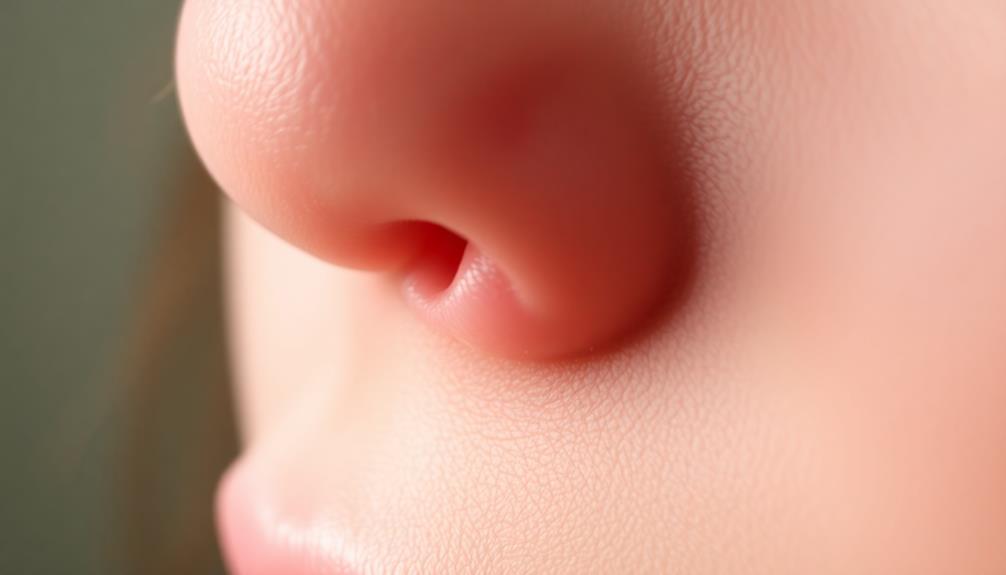
When getting a bridge piercing, it's important to be aware of the potential risks and complications involved. One of the primary concerns is the risk of infection, which can present as swelling, redness, and discharge if you don't follow proper aftercare.
Additionally, allergic reactions may occur, especially if your jewelry contains nickel. To avoid this, it's vital to opt for hypoallergenic materials like titanium or surgical steel.
Another significant risk is keloids, which are excessive scars that can develop in about 10% of individuals, particularly those with a genetic predisposition. These might require medical treatment to manage.
The jewelry size and fit also play an important role in minimizing complications. Ill-fitting jewelry can lead to irritation, migration, or even rejection of the piercing, given that bridge piercings are classified as surface piercings, making them more susceptible to these issues.
Lastly, keep in mind that migration is a concern due to the thin skin on the bridge of your nose. By understanding these risks and complications, you can make a more informed decision about whether a bridge piercing is right for you.
Jewelry Options and Recommendations
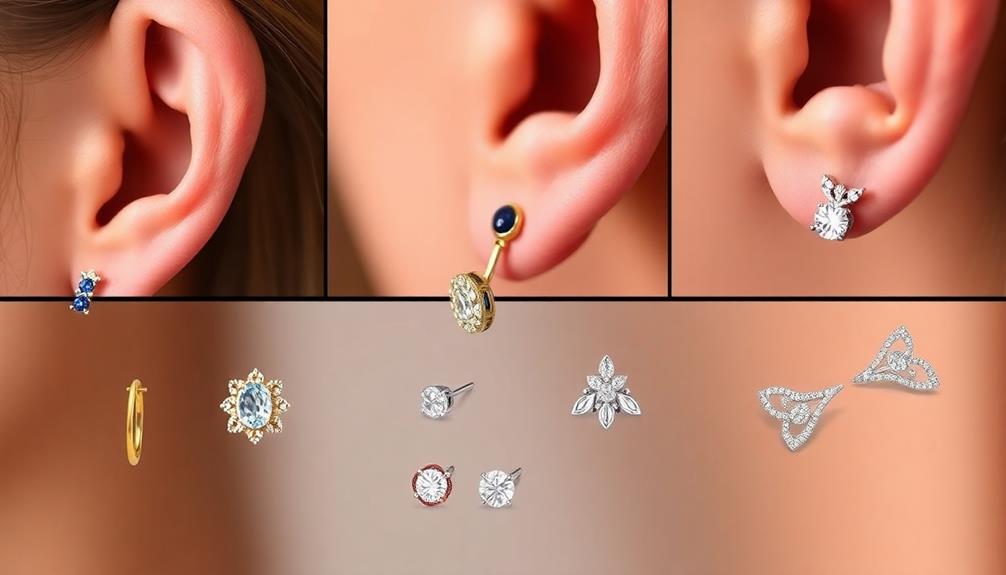
Understanding the potential risks and complications of bridge piercings helps you make informed choices about your jewelry options. Choosing the right jewelry is essential for a successful healing process and your overall experience.
For instance, selecting high-quality materials can greatly influence your comfort level during healing, similar to how color accuracy impacts overall image quality in projectors.
Here are some recommendations for bridge piercing jewelry:
- Straight Barbell: This is the most recommended type, as it minimizes the risk of rejection and promotes proper healing.
- High-Quality Materials: Opt for materials like titanium or surgical steel to reduce irritation and allergic reactions. These materials are both durable and body-friendly.
- Gauge and Size: Work with professional piercers to determine the appropriate gauge and size that suits your individual anatomy, ensuring a perfect fit.
- Decorative Options: Once your piercings are healed, you can explore various styles with gemstones, spikes, or unique shapes to express your personal style. If you need something discreet for professional settings, consider retainers.
Frequently Asked Questions
Is It Worth Getting a Bridge Piercing?
Deciding if it's worth getting a bridge piercing depends on your personal style and willingness to commit to aftercare. Weigh the aesthetic appeal against potential complications and healing time before making your choice.
What Is a Concern About a Bridge Piercing?
Did you know that about 30% of surface piercings face rejection? When considering a bridge piercing, you should worry about migration, infection, and tearing, especially if you're not diligent with aftercare and jewelry selection.
Can Everyone Get a Bridge Piercing?
Not everyone can get a bridge piercing. You'll need enough soft tissue at your nose's bridge, and if you have skin conditions or allergies, consult a professional piercer to verify it's suitable for you.
What Does a Bridge Piercing Symbolize?
A bridge piercing's like a bold brushstroke on your canvas, symbolizing individuality and self-expression. It can represent a personal milestone or transformation, connecting you to your identity and showcasing your unique style against societal norms.
Conclusion
If you're considering a bridge piercing, think of it like starting a new adventure: exciting but requiring careful planning. Weigh the pros and cons, and make sure you're ready for the commitment. With proper aftercare and attention to safety, you can enjoy this unique style choice. Remember, it's all about what feels right for you. So, take the plunge, and let your personality shine through your new piercing!
Hi, my name is Danielle, and I’m an author for piercings-body.com. I have a passion for writing and love to share my knowledge on all things body piercing-related. I’m also a huge advocate for safe body modification practices and believe everyone should be able to make informed decisions about their bodies. When I’m not writing or blogging, I enjoy spending time with my family and friends, practicing yoga, and exploring new places.







